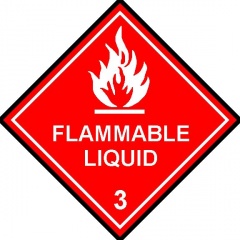Difference between revisions of "Acrylonitrile"
(→Risk factors) |
m (→Shipment / Storage) |
||
| (One intermediate revision by one other user not shown) | |||
| Line 13: | Line 13: | ||
==Shipment / Storage== | ==Shipment / Storage== | ||
Colourless, mobile liquid with a mild pungent odour.<br><br> | Colourless, mobile liquid with a mild pungent odour.<br><br> | ||
| − | Flashpoint:-5°C. Explosive limits: 3% to 17%. Partially miscible with water. Toxic if swallowed, by skin | + | Flashpoint:-5°C. Explosive limits: 3% to 17%. Partially miscible with water. Toxic if swallowed, by skin contact or by inhalation. Practice has shown that this substance may leak from packages that ordinarily are leak proof to other [[chemicals]] |
<br><br> | <br><br> | ||
For overseas carriage aspects of chemicals, the readers are recommended to acquire or have access to a good chemical dictionary, and a copy of the International Maritime Dangerous Goods (IMDG) Code, issued by the International Maritime Organisation. Also consult the applicable MSDS sheet. | For overseas carriage aspects of chemicals, the readers are recommended to acquire or have access to a good chemical dictionary, and a copy of the International Maritime Dangerous Goods (IMDG) Code, issued by the International Maritime Organisation. Also consult the applicable MSDS sheet. | ||
| Line 24: | Line 24: | ||
<br><br> | <br><br> | ||
There are two main excretion processes of acrylonitrile. The primary method is excretion in urine when acrylonitrile is metabolized by being directly conjugated to glutathione. The other method is when acrylonitrile is metabolized with 2-cyanoethylene oxide to produce cyanide end products that ultimately forms thiocyanate, which is excreted via urine, or carbon dioxide and eliminated through the lungs. | There are two main excretion processes of acrylonitrile. The primary method is excretion in urine when acrylonitrile is metabolized by being directly conjugated to glutathione. The other method is when acrylonitrile is metabolized with 2-cyanoethylene oxide to produce cyanide end products that ultimately forms thiocyanate, which is excreted via urine, or carbon dioxide and eliminated through the lungs. | ||
| + | [[Category:Miscellaneous]] | ||
| + | [[Category:Products]] | ||
Latest revision as of 12:04, 8 January 2021
| Infobox on Acrylonitrile | |
|---|---|
| Example of Acrylonitrile |  |
| Facts | |
| Origin | - |
| Stowage factor (in m3/t) | - |
| Humidity / moisture | - |
| Ventilation | - |
| Risk factors | See text |
Acrylonitrile
Description / Application
Acrylonitrile is a chemical compound with the formula C3H3N. This colourless liquid often appears yellow due to impurities. It is an important monomer for the manufacture of useful plastics such as polyacrylonitrile. In terms of its molecular structure, it consists of a vinyl group linked to a nitrile.
Acrylonitrile is used principally as a monomer to prepare polyacrylonitrile, a homopolymer, or several important copolymers, such as styrene-acrylonitrile (SAN), acrylonitrile butadiene styrene (ABS), acrylonitrile styrene acrylate (ASA), and other synthetic rubbers such as acrylonitrile butadiene (NBR). Dimerization of acrylonitrile affords adiponitrile, used in the synthesis of certain polyamides. Small amounts are also used as a fumigant. Acrylonitrile and derivatives, such as 2-chloro-acrylonitrile, are dienophiles in Diels-Alder reactions. Acrylonitrile is also a precursor in the industrial manufacture of acrylamide and acrylic acid.
Shipment / Storage
Colourless, mobile liquid with a mild pungent odour.
Flashpoint:-5°C. Explosive limits: 3% to 17%. Partially miscible with water. Toxic if swallowed, by skin contact or by inhalation. Practice has shown that this substance may leak from packages that ordinarily are leak proof to other chemicals
For overseas carriage aspects of chemicals, the readers are recommended to acquire or have access to a good chemical dictionary, and a copy of the International Maritime Dangerous Goods (IMDG) Code, issued by the International Maritime Organisation. Also consult the applicable MSDS sheet.
Risk factors
Acrylonitrile is highly flammable and toxic. It undergoes explosive polymerization. The burning material releases fumes of hydrogen cyanide and oxides of nitrogen. It is classified as a Class 2B carcinogen (possibly carcinogenic) by the International Agency for Research on Cancer (IARC), and workers exposed to high levels of airborne acrylonitrile are diagnosed more frequently with lung cancer than the rest of the population.
Acrylonitrile increases cancer in high dose tests in male and female rats and mice.
Pathways of exposure for humans include emissions, auto exhaust, and cigarette smoke that can expose the human subject directly if they inhale or smoke. Routes of exposure include inhalation, oral, and to a certain extent dermal uptake (tested on human volunteers and in rat studies).
There are two main excretion processes of acrylonitrile. The primary method is excretion in urine when acrylonitrile is metabolized by being directly conjugated to glutathione. The other method is when acrylonitrile is metabolized with 2-cyanoethylene oxide to produce cyanide end products that ultimately forms thiocyanate, which is excreted via urine, or carbon dioxide and eliminated through the lungs.











